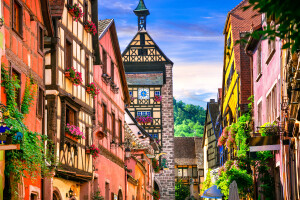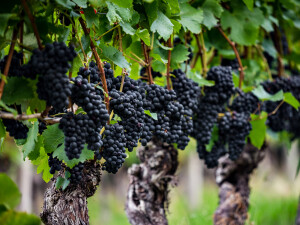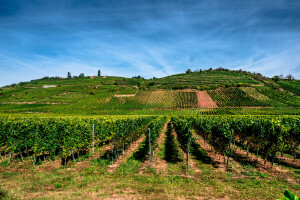Big news for lovers of all things Alsace! Two (of the 51) Grand Cru AOCs of Alsace have revised their regulations so that they now allow for the production of Alsace Grand Cru Rouge—made with 100% Pinot Noir!
Before these changes—announced via publication in the Journal Officiel de la République Française on May 13, 2022—wines of the Alsace Grands Crus were exclusively white. In addition—with very few exceptions*—only varietal wines produced from one of the noble grapes of Alsace (Riesling, Pinot Gris, Gewurztraminer, and Muscat) were allowed to be labeled as Alsace Grand Cru AOC wines.
However, things have evolved and now Alsace Grand Cru Hengst and Alsace Grand Cru Kirchberg de Barr are approved for vins blancs et rouges tranquilles (both white and red wines, still/not sparkling). All other Grand Cru AOCs sont réservées aux vins blancs tranquilles (are reserved for still white wines).
Alsace Grand Cru Hengst covers 53 hectares/131 acres in an area south of the Haut-Rhin commune of Wintzenheim (near Colmar). Vines have been planted here—at altitudes of 260–350 meters/853–1,150 feet asl, along a steep hillside sloping to the southeast—since the 9th century. The soils—consisting of clay and marl flecked with limestone—help to enable the ripening of the Pinot Noir grapes of the region, known to produce wines with silky tannins and lively flavor.
The region’s Pinot Noir vineyards must have a minimum planting density of 5,500 vines per hectare and red wines must have a minimum of 12.5% alcohol by volume. The Alsace Grand Cru Hengst AOC was first approved in 1983 for white wines; red wines will be allowed as of the release of the 2021 vintage.
Alsace Grand Cru Kirchberg de Barr covers 40 hectares/99 acres located on a steep hill (with an incline of almost 30°) overlooking the Bas-Rhin commune of Barr. The vineyards enjoy an ideal south/southeast aspect and an average elevation of 220–350 meters/722–1,150 feet asl. The soil consists of thick deposits of clay, limestone, and marl interspersed with gravel (that helps to retain warmth). The area has a unique sun capture and a slightly warmer temperature than surrounding areas (as the cold air flows downhill). All of this combines to create an ideal micro-climate for Pinot Noir.
The region’s Pinot Noir vineyards must have a minimum planting density of 5,000 vines per hectare and red wines must have a minimum of 12% alcohol by volume. The Alsace Grand Cru Kirchberg de Barr AOC was first approved in 1983 for white wines; red wines will be allowed as of the release of the 2021 vintage.
All wines produced under the category of Alsace Grand Cru/Rouge must adhere to the following new standards:
- They must undergo malolactic fermentation (maximum allowed malic acid content is 0.4 grams per liter)
- They must be dry (maximum allowed level of fermentable sugars is 2 grams per liter)
- They must be aged until (at least) October 1 of the year following the harvest
- As is true of all Alsace Grand Cru AOC wines, they must vintage-dated and packaged in the traditional Flûte d’Alsace bottle
Welcome to the world, Alsace Grand Cru Rouge!
As with all such updates, this change will need to wind its way through EU authorization; however, as the government of France has granted their approval, the changes will be in force (as scheduled) with the release of the wines of the 2021 vintage. If the EU fails to approve the amendment, the regulation will be rescinded (although this is quite unlikely to happen).
*Previous exceptions to the “only varietal wines made using the noble varieties” rule include Zotzenberg (approved for the use of Sylvaner) and Kaefferkopf (approved for white blends).
References/for more information:
- Journal Officiel de la Republique Francaise May 13 2022-Alsace Grand Cru AOC
- Cahier des Charges-Proposal re Alsace Grand Cru AOC (includes notations of the updates vis-à-vis the previous document)
- Vins d’Alsace—Kirchberg de Barr
- Vins d’Alsace—Hengst
Post authored by Jane A. Nickles…your blog administrator: jnickles@societyofwineeducators.org



Super Exciting!
Pingback: Pinot Noir Grand Cru? Alsácia agora também tem esta opção - Wine Fun